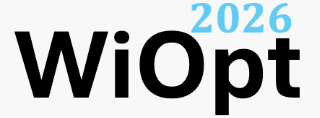
WiOpt 2026 Workshop on
Modeling and Optimization for Semantic Communications (MOSC)
June 6, 2026, Columbus, OH, USA
Call for Workshop Papers
A departure from traditional communication theories, methodologies, and network architectures is essential to fully harness the potential of emerging technologies such as the Internet of Things (IoT), cyber-physical systems, and edge computing, as well as the evolution toward 6G networks and the widespread adoption of AI/ML techniques. This shift is crucial to enable more efficient, reliable, and accurate forms of machine-type communications, calling for innovative communication and networking models and protocols specifically designed for this purpose. This emerging paradigm, known as semantic communications, encompasses both the semantic level, which concerns how accurately the transmitted symbols convey the intended meaning, and the effectiveness level, often referred to as goal-oriented communications, which focuses on the usefulness of the exchanged information in relation to the objective of the communication in interactive contexts.
An initial step toward this vision was marked by the introduction of the Age of Information (AoI) metric about a decade ago, which quantified the freshness of information at the receiver and inspired a rich line of research on timely communications. However, AoI and its extensions primarily address when and how often information should be transmitted, rather than what information is most relevant to transmit. To bridge this gap, recent research has expanded toward metrics and frameworks that capture the semantic and goal-oriented dimensions of communication. These include Quality of Information (QoI), Value of Information (VoI), Age of Incorrect Information (AoII), and other task-aware or distortion-based measures that assess how much a message contributes to the effectiveness of decision-making, estimation, or control. The field has further evolved toward joint source–channel coding guided by application-layer semantics, the integration of ML-driven encoders and decoders, and the exploration of finite-blocklength regimes for real-time, goal-oriented information exchange. As a result, semantic communications have become a truly interdisciplinary frontier, connecting networking, information theory, machine learning, linguistics, and cognitive sciences.
The 3rd Workshop on Modeling and Optimization for Semantic Communications (MOSC), held in conjunction with the International Symposium on Modeling and Optimization in Mobile, Ad hoc, and Wireless Networks (WiOpt), aims to provide a dedicated forum for researchers and technical experts to share the latest advances, present significant and emerging results in goal-oriented and semantic communications, and identify new challenges and future research opportunities in the field.
We invite the submission of original papers that advance both the fundamental principles and the practical applications of semantic metrics and communication protocols. Topics of interest include, but are not limited to:
- Novel Models, Solutions and Metrics for Semantic and Goal-oriented communications
- Information-theoretic Limits of Semantic and Goal-oriented Communications
- Source and Channel Coding for Semantic and Goal-oriented Communications
- Freshness and Semantics of Information in the Finite Blocklength Regime
- Random Access and Gossiping Protocols for Semantic and Goal-oriented Communications
- Freshness-Value-Perception Tradeoffs in Semantic Communications
- Freshness and Semantics of Information in Real-time Learning, Estimation, Computation, and Control
- Freshness and Semantics of Information in Consensus and Distributed Computation
- Network Architectures and Protocols for Semantic and Goal-oriented Communications
- Resource Allocation and Management for Semantic and Goal-oriented Communications
- Modeling and Performance Analysis for Semantic and Goal-oriented Communications
- ML/AI Techniques for Semantic and Goal-oriented Communications
- Distributed or Multi-agent Learning for Semantic and Goal-oriented Communications
- Security, Privacy, and Trust in Semantic and Goal-oriented Communications
- Energy Efficiency and Sustainability in Semantic and Goal-oriented Communications
- Experiments, Test-beds, and Demos for Age of Information, Goal-oriented and Semantic Communications
Steering Committee:
Yin Sun, Auburn University, AL, USA
Elif Uysal, Middle East Technical University, Turkey
General Co-chairs:
Yu Cheng, Illinois Institute of Technology, IL, USA
Yin Sun, Auburn University, AL, USA
Technical Program Co-chairs:
Fabio Busacca, University of Catania, Italy
Andrea Panebianco, Auburn University, AL, USA
Howard Hao Yang, Zhejiang University, China
Important Dates
Paper submission: Sunday, 8 March 2026 11:59 PM EDT
Notification of acceptance: Sunday, 29 March 2026
Camera ready paper: Sunday, 5 April 2026 11:59 PM EDT
Submission Guidelines
Submitted papers should follow WiOpt guidelines at: https://wiopt2026.github.io/. Authors are invited to submit original papers of no more than 8 pages (standard IEEE proceedings, two-column, 10 pt font, etc.), including figures, tables, and references, in PDF format. All papers will be submitted through EDAS: https://edas.info/N34452.
